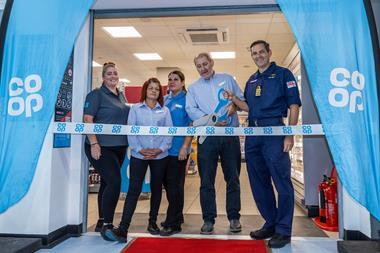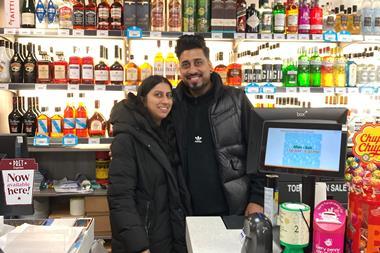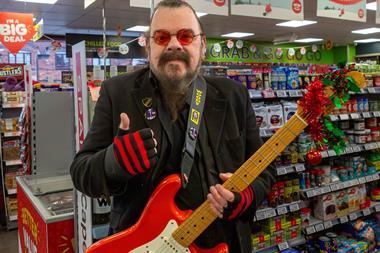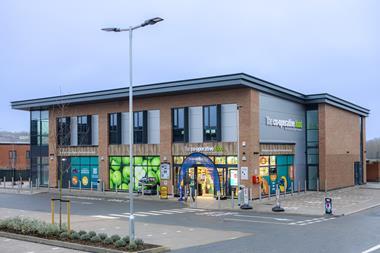Epos is one of the most important innovations in the c-store sector and has helped countless retailers grow their business substantially. However, according to recent research, there are still huge numbers of store owners who haven't yet embraced it.
A survey by epos provider Actinic last November found that only one-third of the retail businesses it polled have an epos system. And just 13% of the businesses that don't are strongly considering installing one.
So why the reluctance? Actinic chief executive Chris Barling believes it has a lot to do with the initial cost. "For some retailers, especially those who have been in the industry a long time, their approach to business is to not spend any money if they can get away with it. They know that an epos system will cost them money, but they don't know for sure that it will help their business or save money in the long term."
Torex product manager Huw Carey adds: "If independent retailers haven't yet made the investment in epos it's usually because they haven't grasped just how much such systems can do for them, or they have assumed that their business is too small to carry the investment. In fact, any store would see a benefit. Even smaller c-stores can gain from being able to look at each department or category and see how it's performing."
According to Carey, another advantage that is often overlooked is the fact that an epos system can help retailers log sales data, enabling forecasts for seasonal variations in demand. "By tracking sales history throughout the day and week, retailers can build up a picture of peaks and troughs in trade and schedule staff much more effectively to cope with periods of high demand, and reduce levels during slack times," he adds.
YP Electronics says that by being proactive rather than reactive, smaller retailers can adapt much quicker than the multiples, especially when it comes to consumer behaviour. "It's all about change and how quickly you can achieve it," says YP Electronics managing director Jamie Shipstone. "You need a fully functional, integrated and intuitive epos solution to grow as a professional retailer, especially in the current economic climate."
YP Electronics recently revealed that retailers who use its SiNQUA system have increased sales by 3% year on year.
taking stock
Amul Naik, who runs three Nisa Local stores in London, has been using the Nisa epositive system since last March and has been very impressed. “When designing the system they took into account all of my concerns and modified the system to suit. I had the system set up in my store in Southbury and as a result we went from taking £16,000 per week to £23,000 per week in a matter of months.”
Amul finds that the system is essential for dealing with promotions. “Nisa uploads all of its promotions on to the system and all we have to do is push a button to set them up. It prints out the new price tickets and takes just half-an-hour to get everything ready. Without an epos system, this would take all day.
“Having a strong epos system also allows us to see immediately what’s selling and what’s not,” adds Amul. “This lets us focus on growing the business in other areas.” Spedi Retail Software managing director David Mendus agrees that an epos system can lead to extra profits quickly if used properly. “If a retailer doesn’t add at least 2% to their net margin within a couple of months then either they’re not using it properly, or they were exceptionally good at business before they installed the system,” he says. “One retailer who installed a system with our software found more than £2,000-worth of pricing errors in his stock on the first day!” Efficiency in a convenience store is paramount and NCR retail specialist Helen McInnes points out that an epos system that makes serving customers quickly can make a huge difference to sales. “C-stores rely on passing trade and if someone sees a queue then they might be less likely to buy something. An epos system can help serve people quicker, meaning shorter queues and more satisfied customers.” Adds Carey: “Epos systems can help retailers to facilitate fast, friendly and efficient service at the checkout. They can also integrate newspaper account management, quick lottery payouts and e-top-up of mobile phone payments.”
On top of all this an epos system can also be linked to a store’s security system. “You can place a camera on the till to see what products are being brought to the till,” says Actinic’s Barling. “If a customer brings items to the counter but they aren’t appearing on the monitor, then you know a staff member is not doing their job properly.”
safe and sound
Barling also says that an epos system can be programmed to prevent staff members giving discounts to friends. “If someone scans a price in and then tries to put a discount on it, the system will lock them out until a manager comes along.” According to Carey, the same technology can also help with compliance issues surrounding age-related sales regulations. “Not only does the epos prompt staff to challenge potential underage purchasers, but the recording and transaction details will help ensure that members of staff are taking their responsibilities seriously.”
Amul agrees that this function is useful. “The system we’re using automatically flags up any age-restricted product and prompts the staff member to ask for identification,” he says. “It also creates a record of any time the question is asked and if the customer has been refused.” With the potential to control stock and protect your business from theft, the advantages of epos are clear. So why the wait?
A survey by epos provider Actinic last November found that only one-third of the retail businesses it polled have an epos system. And just 13% of the businesses that don't are strongly considering installing one.
So why the reluctance? Actinic chief executive Chris Barling believes it has a lot to do with the initial cost. "For some retailers, especially those who have been in the industry a long time, their approach to business is to not spend any money if they can get away with it. They know that an epos system will cost them money, but they don't know for sure that it will help their business or save money in the long term."
Torex product manager Huw Carey adds: "If independent retailers haven't yet made the investment in epos it's usually because they haven't grasped just how much such systems can do for them, or they have assumed that their business is too small to carry the investment. In fact, any store would see a benefit. Even smaller c-stores can gain from being able to look at each department or category and see how it's performing."
According to Carey, another advantage that is often overlooked is the fact that an epos system can help retailers log sales data, enabling forecasts for seasonal variations in demand. "By tracking sales history throughout the day and week, retailers can build up a picture of peaks and troughs in trade and schedule staff much more effectively to cope with periods of high demand, and reduce levels during slack times," he adds.
YP Electronics says that by being proactive rather than reactive, smaller retailers can adapt much quicker than the multiples, especially when it comes to consumer behaviour. "It's all about change and how quickly you can achieve it," says YP Electronics managing director Jamie Shipstone. "You need a fully functional, integrated and intuitive epos solution to grow as a professional retailer, especially in the current economic climate."
YP Electronics recently revealed that retailers who use its SiNQUA system have increased sales by 3% year on year.
taking stock
Amul Naik, who runs three Nisa Local stores in London, has been using the Nisa epositive system since last March and has been very impressed. “When designing the system they took into account all of my concerns and modified the system to suit. I had the system set up in my store in Southbury and as a result we went from taking £16,000 per week to £23,000 per week in a matter of months.”
Amul finds that the system is essential for dealing with promotions. “Nisa uploads all of its promotions on to the system and all we have to do is push a button to set them up. It prints out the new price tickets and takes just half-an-hour to get everything ready. Without an epos system, this would take all day.
“Having a strong epos system also allows us to see immediately what’s selling and what’s not,” adds Amul. “This lets us focus on growing the business in other areas.” Spedi Retail Software managing director David Mendus agrees that an epos system can lead to extra profits quickly if used properly. “If a retailer doesn’t add at least 2% to their net margin within a couple of months then either they’re not using it properly, or they were exceptionally good at business before they installed the system,” he says. “One retailer who installed a system with our software found more than £2,000-worth of pricing errors in his stock on the first day!” Efficiency in a convenience store is paramount and NCR retail specialist Helen McInnes points out that an epos system that makes serving customers quickly can make a huge difference to sales. “C-stores rely on passing trade and if someone sees a queue then they might be less likely to buy something. An epos system can help serve people quicker, meaning shorter queues and more satisfied customers.” Adds Carey: “Epos systems can help retailers to facilitate fast, friendly and efficient service at the checkout. They can also integrate newspaper account management, quick lottery payouts and e-top-up of mobile phone payments.”
On top of all this an epos system can also be linked to a store’s security system. “You can place a camera on the till to see what products are being brought to the till,” says Actinic’s Barling. “If a customer brings items to the counter but they aren’t appearing on the monitor, then you know a staff member is not doing their job properly.”
safe and sound
Barling also says that an epos system can be programmed to prevent staff members giving discounts to friends. “If someone scans a price in and then tries to put a discount on it, the system will lock them out until a manager comes along.” According to Carey, the same technology can also help with compliance issues surrounding age-related sales regulations. “Not only does the epos prompt staff to challenge potential underage purchasers, but the recording and transaction details will help ensure that members of staff are taking their responsibilities seriously.”
Amul agrees that this function is useful. “The system we’re using automatically flags up any age-restricted product and prompts the staff member to ask for identification,” he says. “It also creates a record of any time the question is asked and if the customer has been refused.” With the potential to control stock and protect your business from theft, the advantages of epos are clear. So why the wait?
Retailer's view
Dean Holborn
Redhill,
Surrey
"There's no real argument to be made for not installing an epos system," says Dean Holborn, who has two stores in Redhill, Surrey. "We never would have coped without epos. Even when I'm at home I can check stock levels, process orders and see what sales are like. That level of support is a massive help."
Dean has recently upgraded to the YP SiNQUA system from YP Electronics and says that retailers looking to install epos for the first time should look for a user-friendly interface and after-sales support. "The system I have has massive touch-screens that make it easy for staff to use. I would also encourage people to make sure support is there. There are plenty of cheap systems for sale, but suppliers don't always provide help once the system has been installed."
Dean has more than 4,000 lines in each of his stores and when the government lowered the VAT rate from 17.5% to 15%, it took just minutes for him to change the prices of products affected. "Once I changed the VAT code on the system it was all done. To do all of that manually would have taken days."
Dean Holborn
Redhill,
Surrey
"There's no real argument to be made for not installing an epos system," says Dean Holborn, who has two stores in Redhill, Surrey. "We never would have coped without epos. Even when I'm at home I can check stock levels, process orders and see what sales are like. That level of support is a massive help."
Dean has recently upgraded to the YP SiNQUA system from YP Electronics and says that retailers looking to install epos for the first time should look for a user-friendly interface and after-sales support. "The system I have has massive touch-screens that make it easy for staff to use. I would also encourage people to make sure support is there. There are plenty of cheap systems for sale, but suppliers don't always provide help once the system has been installed."
Dean has more than 4,000 lines in each of his stores and when the government lowered the VAT rate from 17.5% to 15%, it took just minutes for him to change the prices of products affected. "Once I changed the VAT code on the system it was all done. To do all of that manually would have taken days."
What's next in technology?
According to Actinic’s Chris Barling, contactless payment will become very popular over the course of this year and 2010. Recently the subject of an unusual advertising campaign by Barclays, which showed a man water-sliding through a city, the system will enable shoppers to pay for goods costing £10 and under without having to swipe their debit card or enter a PIN number.
All of the major UK banks will be introducing contactless payments as standard in the coming months so retailers may soon start to see a demand for it from customers.
From contactless payment to contactless service, and NCR’s Helen McInnes believes that the self-service checkouts that have already been introduced in supermarkets will become more popular in c-stores soon. “The unit will be smaller than the supermarket model, but it will provide the same functions.
“Having a self-checkout machine will increase service points, free up staff for other duties and attract customers in a hurry.”
According to Actinic’s Chris Barling, contactless payment will become very popular over the course of this year and 2010. Recently the subject of an unusual advertising campaign by Barclays, which showed a man water-sliding through a city, the system will enable shoppers to pay for goods costing £10 and under without having to swipe their debit card or enter a PIN number.
All of the major UK banks will be introducing contactless payments as standard in the coming months so retailers may soon start to see a demand for it from customers.
From contactless payment to contactless service, and NCR’s Helen McInnes believes that the self-service checkouts that have already been introduced in supermarkets will become more popular in c-stores soon. “The unit will be smaller than the supermarket model, but it will provide the same functions.
“Having a self-checkout machine will increase service points, free up staff for other duties and attract customers in a hurry.”






















No comments yet